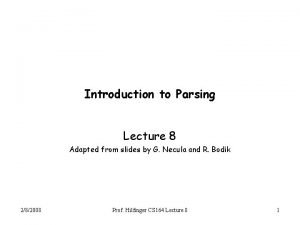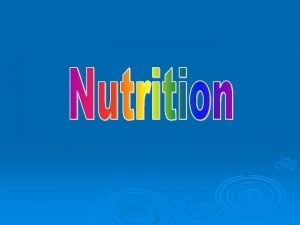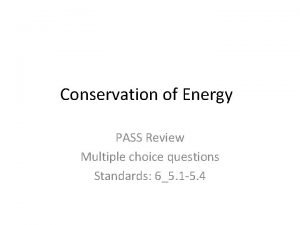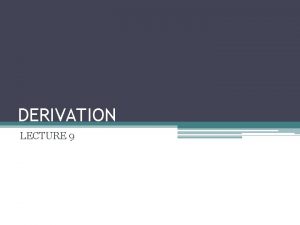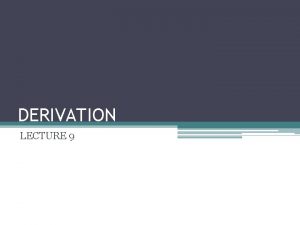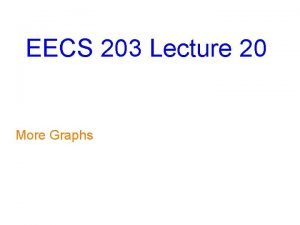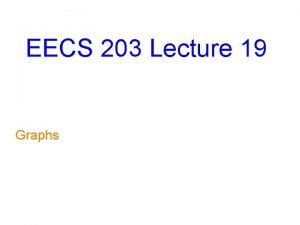Derivation of Energy from food stuffs Derivation of






- Slides: 6

Derivation of Energy from food stuffs Derivation of energy from the metabolism of the three basic foodstuffs by way of the final common path : the Krebs cycle and oxidative phosphorylation. FAT Lipases Lipolysis Glycerol and free fatty acids Carnitine Beta oxidation Acetyl coenzyme A CARBOHYDRATE(glycogen) Phosphorylase Glucose PROTEIN Proteases Polypeptides P eptidases Glycolysis Amino acids Phosphofructokinase Pyruvic acid Acetyl coenzyme A Krebs cycle Citric dehydrogenase NADH Oxidative phosphorylation NADH O 2 NAD H 2 O Deaminases Transaminases Keto acids

ATP Production from FAT ( Lipid ) - O - FA #1 FAT from Triglycerides Glycerol - O - FA #2 + 3 fatty acid (FA) chains. food stored - O - FA #3 Blood Breakdown FA spilt from Muscles E triglycerides of FA In mitochondrial beta oxidation of FA, acetyl Co. A is generated. Example: Stearic (18 C) +ATP= 9 acetyl Co. A+9 FADH+ 9 NADH. Ac. Co. A-> 9 turns of CAC 9 turnsx(3 NADH/turn)=27 NADH+9 NADH=36 electron pairs x 2. 5 ATP/electron pair 90 ATP 9+9 FADH=18 electron pairs x 1. 5 ATP/electron pair 27 ATP+90 ATP+9 GTP-1 ATP=125 ATP Relative value of FAT & CHo for E 1. 1 g of Fat produces about 2. 5 times more ATP than 1 g of CHo (better E store) 2. FAT supplies E for long duration exercise, when CHo supply may not be enough. 3. When ATP produced per unit O 2 consumed is compared, CH o have 10% better ATP yield than FAT, Example: uses Glucose gives 6 O 2 32 ATP Stearic Acid 26 O 2 125 ATP i. e. Glucose oxidation yields 5. 3 ATP/O 2. Stearate oxidation yields 4. 8 ATP/O 2

Use of Proteins for E Proteins Proteases (Ca dep & indep. ) Amino Acids (AA) Deamination ( removal of the amino groups from the AA ) Transaminases Glutamic Dehydrogenase Keto Acids(pyruvate, oxaloacetate, ketoglutarate) Oxidation( direct or after conv. to pyruvate) CAC ETC & OP ATP ( Energy)

Glucose (Glu) conversion to Glycogen (Gly) or fat The extra Glu is either stored as Gly in the cell or converted into Fat. § Preferentially, through Glycogenesis, Glu is stored as Gly which stores are sufficient to provide E for a few (12 to 24) hours. § When Liver & Muscle cells approach saturation with Gly, excess Glu is converted into fat in the liver and fat cells and is stored in fat cells. Fat stores can yield energy for weeks. Formation of CHO from Proteins and Fats “Gluconeogenesis” • When body’s stores of CHO are below normal, moderate amounts of Glucose can be formed from Amino Acids (AA) derived from protein breakdown (stimulated by Ca & the stress hormone cortisol), from lactate (Cori Cycle), and only from the gycerol portion of fats. This is called Gluconeogenesis. Fatty acids and some amino acids (ketogenic) cannot yield glucose • Most AA can be converted to glucose (glucogenic). • Diminished CHO in the cells and decreased blood sugar are stimuli for increases in Gluconeogenesis

Usage (Fasting) Phase of Metabolism

Absorptive (storage) Phase of Metabolism
